Nice ended the 2019/20 season in fifth place, improving last year’s finish where they ended seventh.
This shows improvement from Patrick Vieira’s side.
It is important to note that the Ligue 1 season ended prematurely with the pandemic.
However, if this improvement goes on, Nice might equal the amazing third place they achieved in the 2016/17 season, where they were the surprise of the league.
Vieira has been coaching the side for two years already and with his contract running out next year, next season will be the most important for him.
Vieira came to Nice back in 2018, making it the second professional club he coached.
Previously he had been the coach of the Manchester City U21 team and New York City FC in the MLS.
Having five years of coaching experience made him one of the Ligue 1 managers with the least experience but Nice gave him a vote of confidence.
So far, it has proven effective.
Comparing the two years, Nice improved their attacking numbers but also worsened their defence.
Last year they only conceded 35 goals which is impressive but this year they had already conceded 38 goals in 28 games.
As for the attack, last year they scored a meagre 30 goals but this year they had already scored 41 goals.
It proves that Vieira might have taken more risk in his philosophy this season and opened up the team more.
It meant the ability to score more goals but taking more risks also meant they conceded more.
In this tactical analysis, we will analyse Vieira’s strategies in his Nice team.
We will also do an analysis of his tactics concerning the improved attack and also how he is struggling more in defence than last year.
Systems and the balance in midfield
This season, the most used formations were 4-4-1-1, 4-1-4-1, and the 4-4-2.
This proves that Patrick Vieira likes having a midfield of four to create a solid midfield.
In this midfield, he normally has a more defensive-minded midfielder and a more creative midfielder.
It is important to note that he also varies more with his formations.
For example, in a game analysed against Monaco, he used the 3-4-2-1 formation.
He did this as Monaco were playing in a formation with no real wingers and this formation meant that Nice could control the midfield with numbers while also creating danger on the wing with wingbacks.
Additionally, it proves that Vieira is not afraid to differ from his original style if needed in a specific match.
The more defensive midfielder is in charge of helping in the build-up as we can see in Figure one, with Khéphren Thuram who dropped to help the centre-backs.
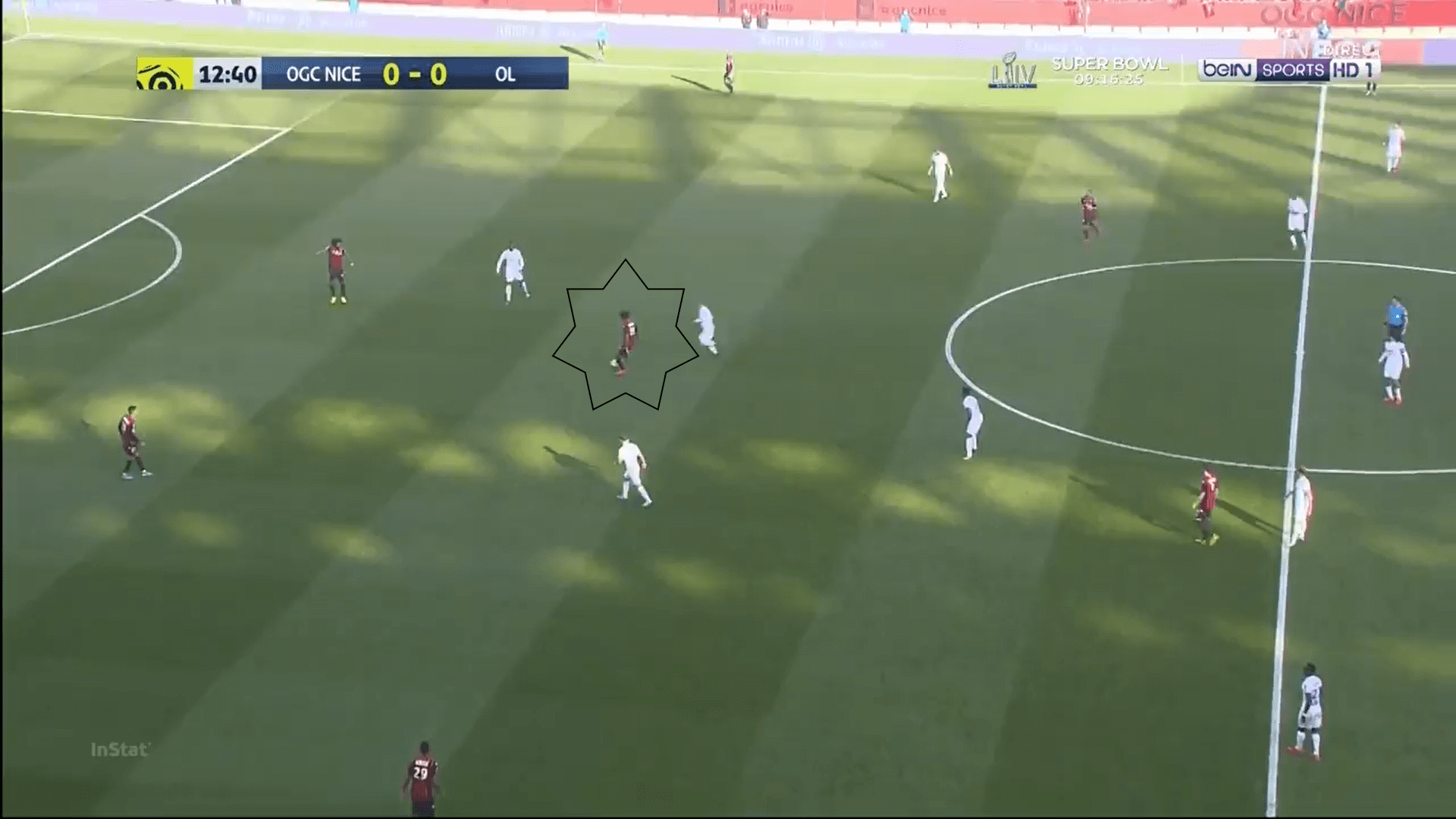
The attacking midfielder has two main roles.
One of them is to be more involved in the attacking phase.
This is usually Pierre Lees-Melou who can go help in attack to both sides and generate superiority in that area where he goes.
For example, in Figure two he is surprising the opponents by making a run in behind on the wing.
By making this run from the midfield, he is also helping his teammate by giving him another attacking option.
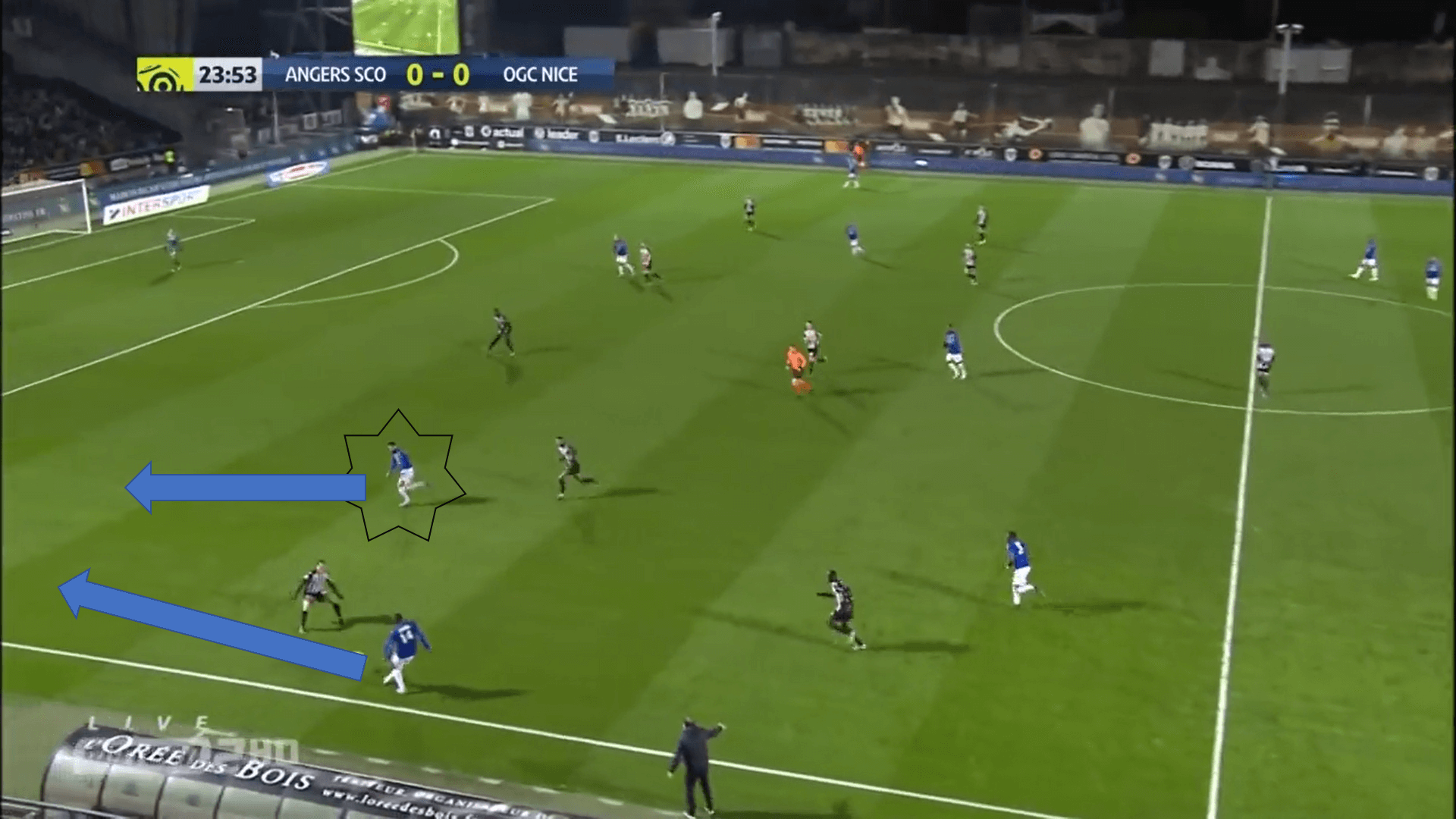
The other main role he has is to help in the high press.
Nice is not known for their high pressing but when they do it, generally the two strikers cover the two centre-backs and the attacking midfielder covers the opponent midfielder who is dropping to help.
This is seen in Figure three.
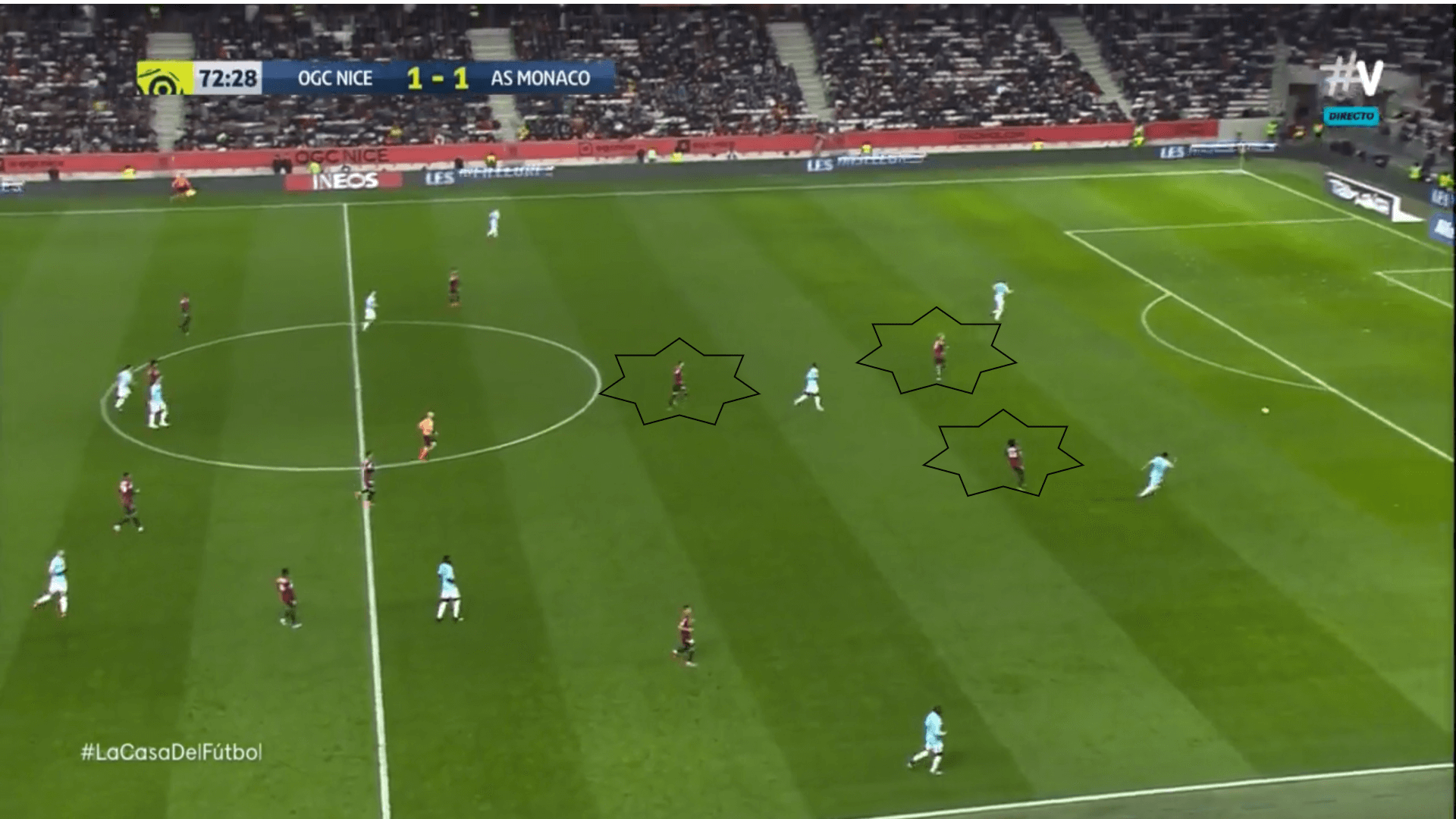
Having two different player profiles in the midfield creates a balance which is great for the team.
This means that when the attacking midfielder is on the attack, the defensive-minded midfielder stays back to cover and prevent counterattacks.
Build-up
Nice has two interesting centre-backs to analyse.
The first one is Dante, the 36-year-old Brazilian who played in Bayern Munich.
The second one is Danilo, a young centre-back who plays well on the ball and previously played in La Liga.
Dante is slower but is more secure with his passes.
That is why he is mainly in charge of making the long passes and passes between the opponent’s midfield.
As seen in Figure four, he specialises in making passes that cut through the opponent.
With these passes in the build-up, Nice get the ball to the attack quicker and these attackers can then turn and face the goal.
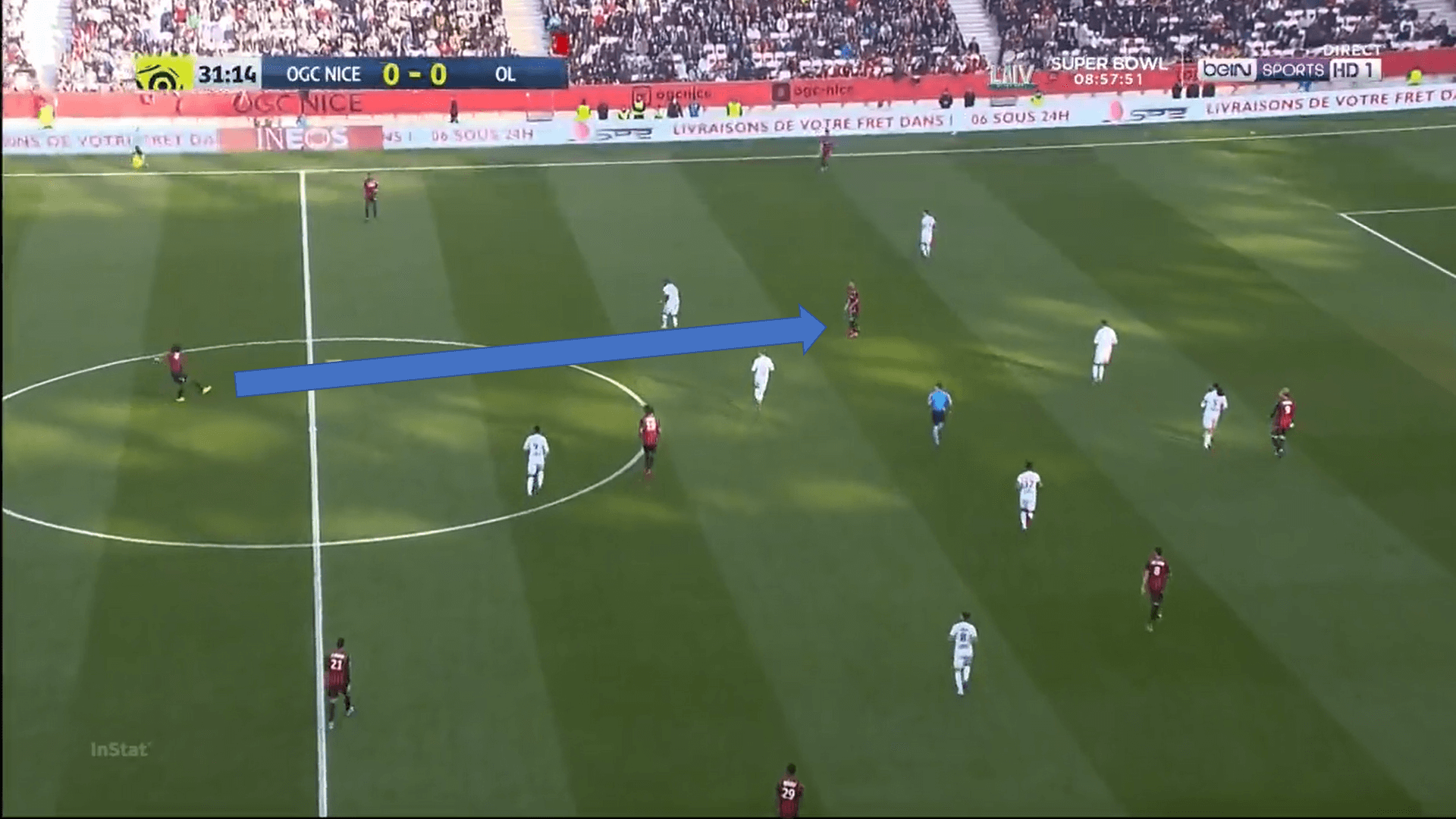
On the other hand, Danilo relies less on his passing but more on his progressive runs.
He is naturally a centre-midfielder, but Vieira put him as centre-back even though he sometimes plays as centre-midfielder.
With this, Vieira is looking for a centre-back who handles the ball well and can drive with the ball to the opponent.
When a centre-back drives with the ball in the build-up, this attracts opponents to him.
If opponents come to press Danilo, that means that they have just left other Nice players alone, opening up spaces.
To prove how Danilo likes to drive with the ball, in Figure five he is receiving a ball from Dante and is turning his head to check if there is anyone near him.
Since in that game, Lyon only had one striker, it was perfect for Danilo.
He then receives the ball and drives deep into midfield, creating superiority in the midfield for Nice and thus, making it easier to connect with teammates.
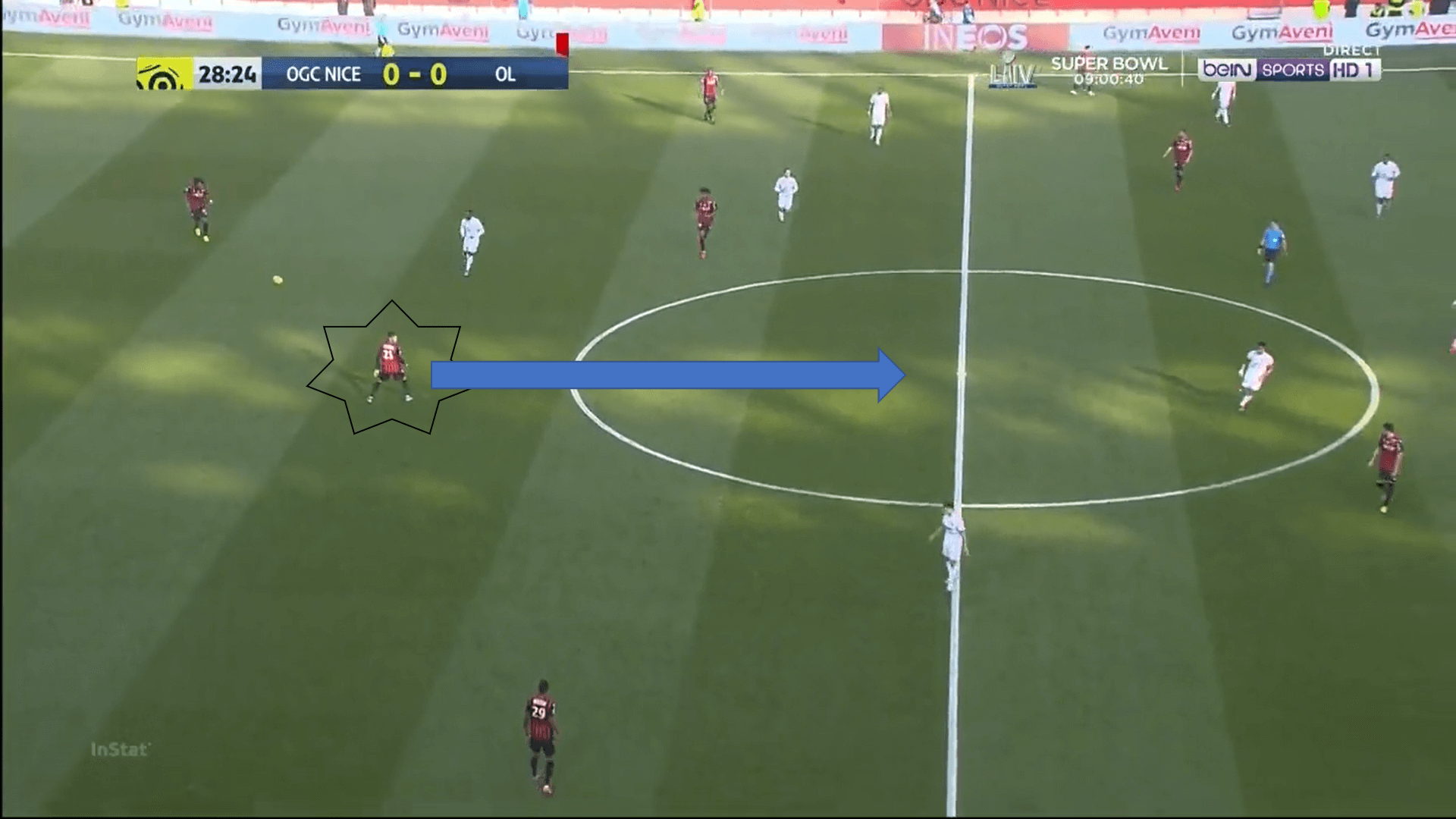
Furthermore, Nice is the Ligue 1 team with the second least losses behind PSG making 83.25 losses per game.
This shows that this build-up system is working better than those of other teams so far.
Attacking
In attack, there are two main strategies they use.
The first one is making the striker Kasper Dolberg drop down and receive the ball.
After this, Dolberg can turn and pass it to one of the wings, as the opponents must have moved more to the middle with him receiving the ball.
In fact, according to Wyscout, 41% of their attacks come through the middle.
This shows that Vieira likes to split the opponents through the middle before either continuing or switching it to a side.
An example of Dolberg dropping down to receive the ball is in Figure six.
In this play, he manages to turn with the ball and pass it to the left-winger.
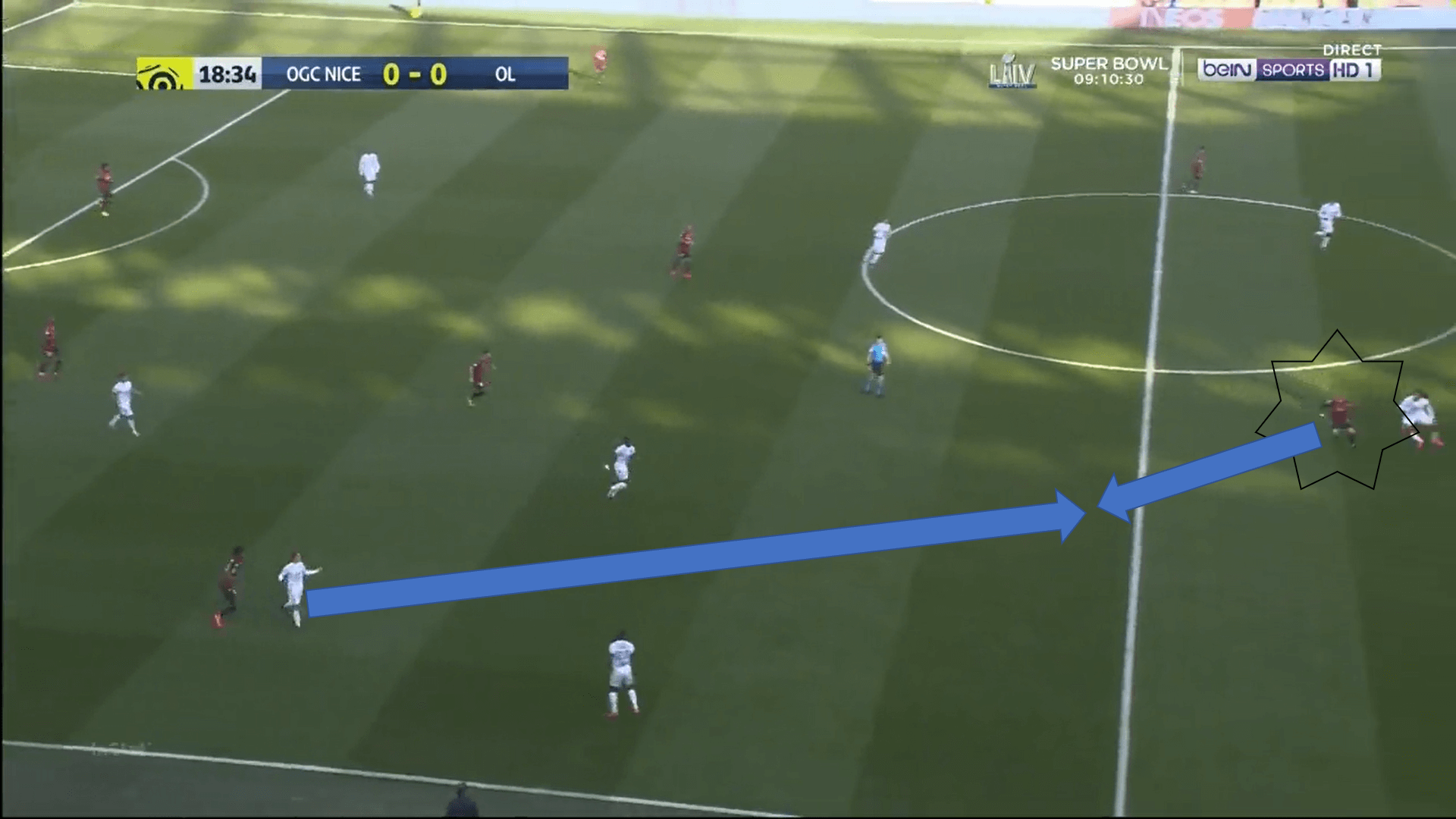
Another interesting movement caused by Dolberg dropping down to receive is when the wingers take advantage of the space left by Dolberg and his marker.
When Dolberg drops, at least one centre-back follows him to put pressure.
This leaves a space in the defence which is exploited by Nice.
Therefore, the tactics Nice utilise involve having a winger run into the space left behind at the same time that Dolberg comes down.
If done well, it would leave the winger alone against the goalkeeper.
An example of this movement is in Figure seven.
Adam Ounas makes the movement in behind the defence just as Dolberg attracts both defenders with his supporting run.
This left Ounas in a very good position but due to a faulty touch, he was not able to take advantage of it.
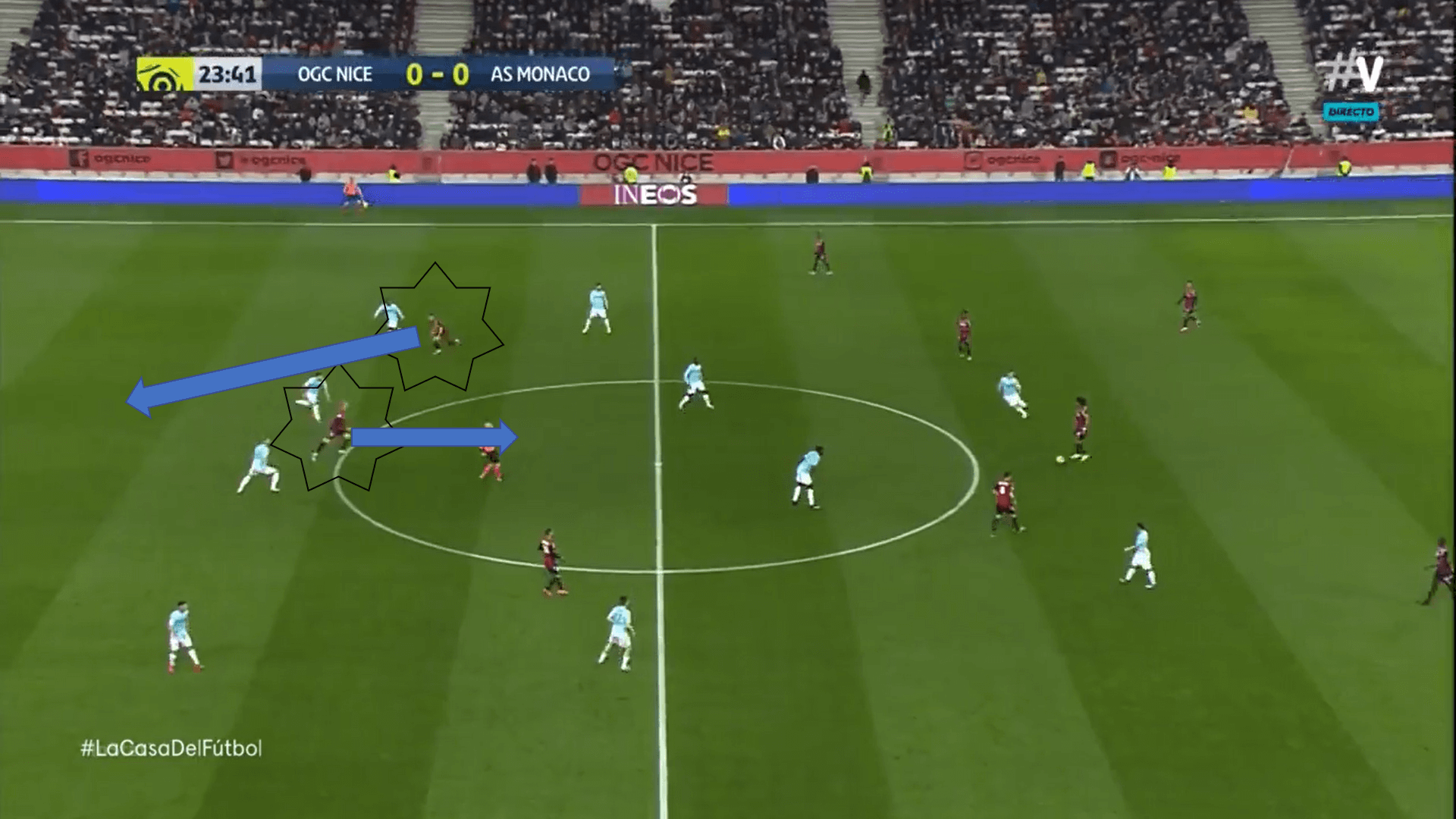
In attack, Nice also pride themselves with their fast wingers who dribble well.
They also like to produce danger through the wings and often try to get the wingers in 1 vs 1 situations.
They do this because their wingers are technical and have a good chance of beating their opponent and thus, create superiority in the attack.
They have different ways to find the wingers, among others.
They both include long balls, but the first method is more secure.
Here, they focus the attack only on one side to make the opponent concentrated there and then quickly switch the ball to the opposite wing, who is placed wide.
In Figure eight, it is clear how the Nice winger is waiting for the oncoming long ball and how the Angers defence is quickly moving to the other side.
When the winger receives the ball, he is then in an excellent position to carry out a 1 vs 1 against the opponent full-back.
In fact, Nice makes the fifth most dribbles per game, making 29.80 per game with a success rate of 51%.
It shows that they believe in the ability of their wingers to create chances for their team.
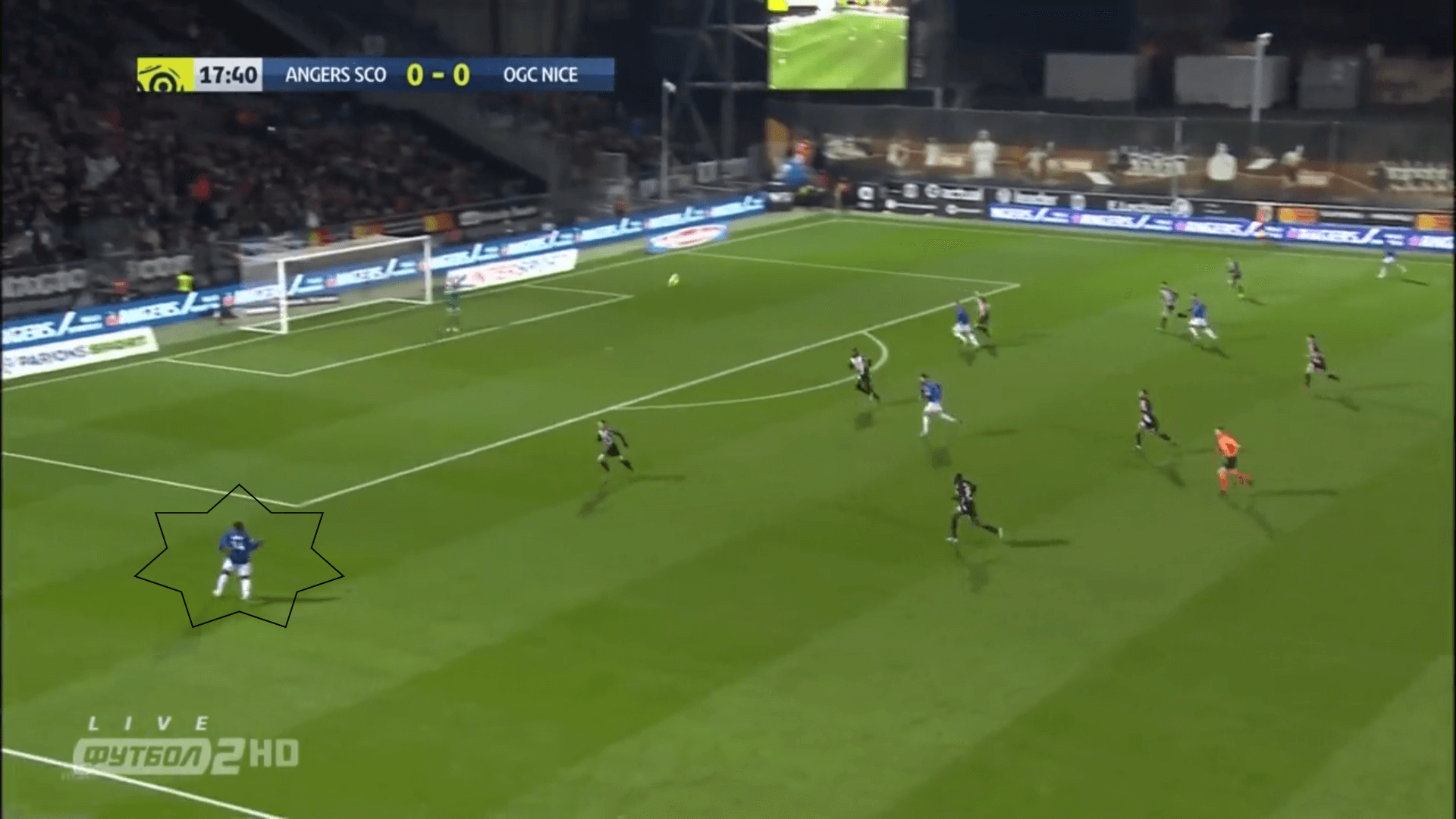
The other method they have is similar to the movement made by the winger when Dolberg dropped down to help.
But this time, they do not need another teammate to confuse the defence.
Here they start from being wide in the pitch and then start going inside, timing when they make the run behind the defence with the teammate that is passing the ball.
Seeing as they are fast wingers, when the opponent team is relatively high up, it is a golden chance for them.
In Figure nine, it is clear how the winger has come inside and with the positioning of his body, has started making the run as soon as his teammate has made the pass.
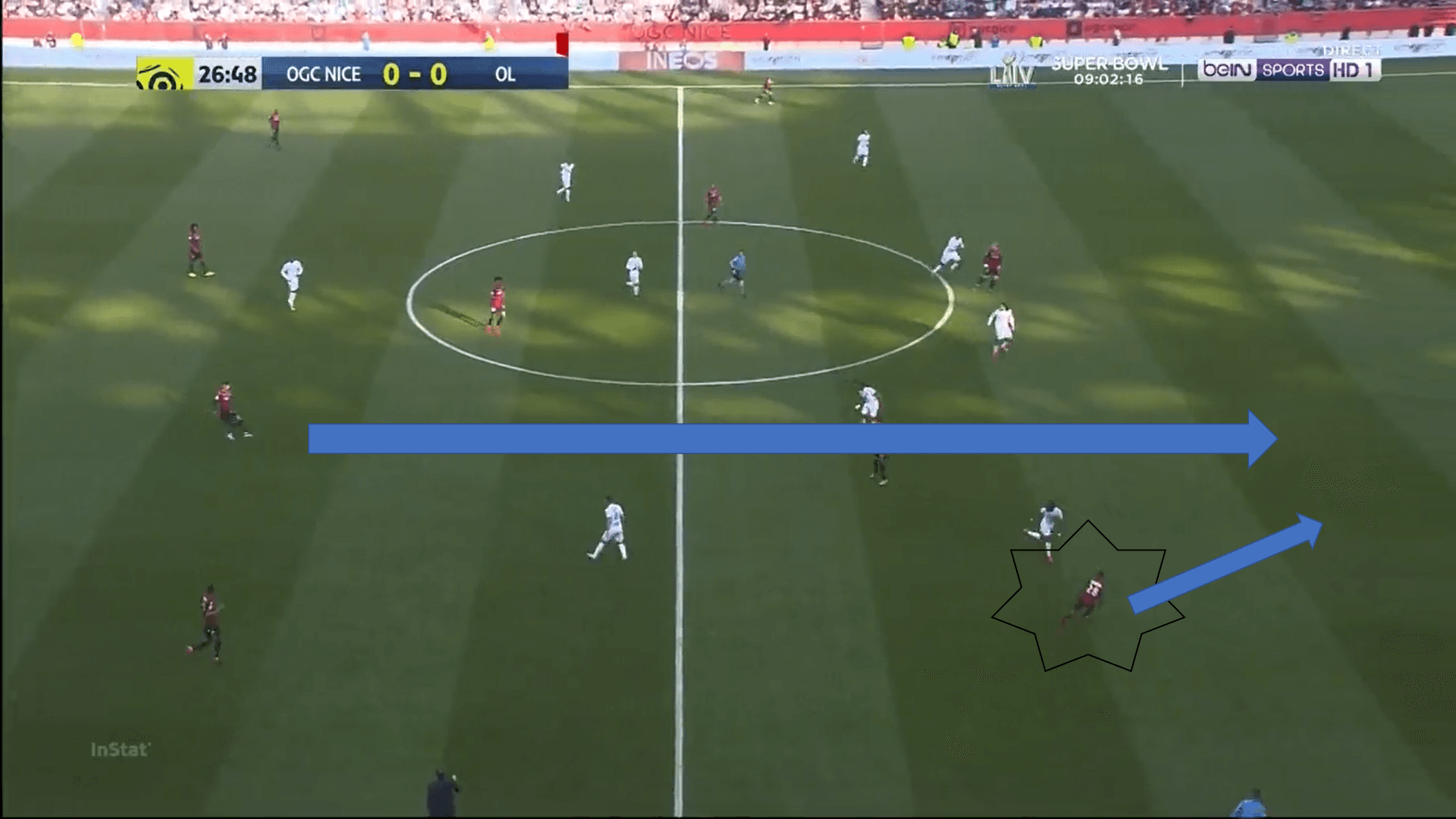
Defending
Nice defend in a medium-high block.
Also, when they lose possession in the opponent’s half, they will try to counter-press if it is really possible.
So, if a Nice player is close to the ball when losing the ball, he will counter-press.
Nonetheless, if the opponent has space and time with the ball, Nice will drop back into their formation.
Nice is the team that makes the least recoveries per game of Ligue 1 with 60.43, showing that they are not that aggressive in their pressing and counter-pressing.
Their medium-high block is shown in Figure 10.
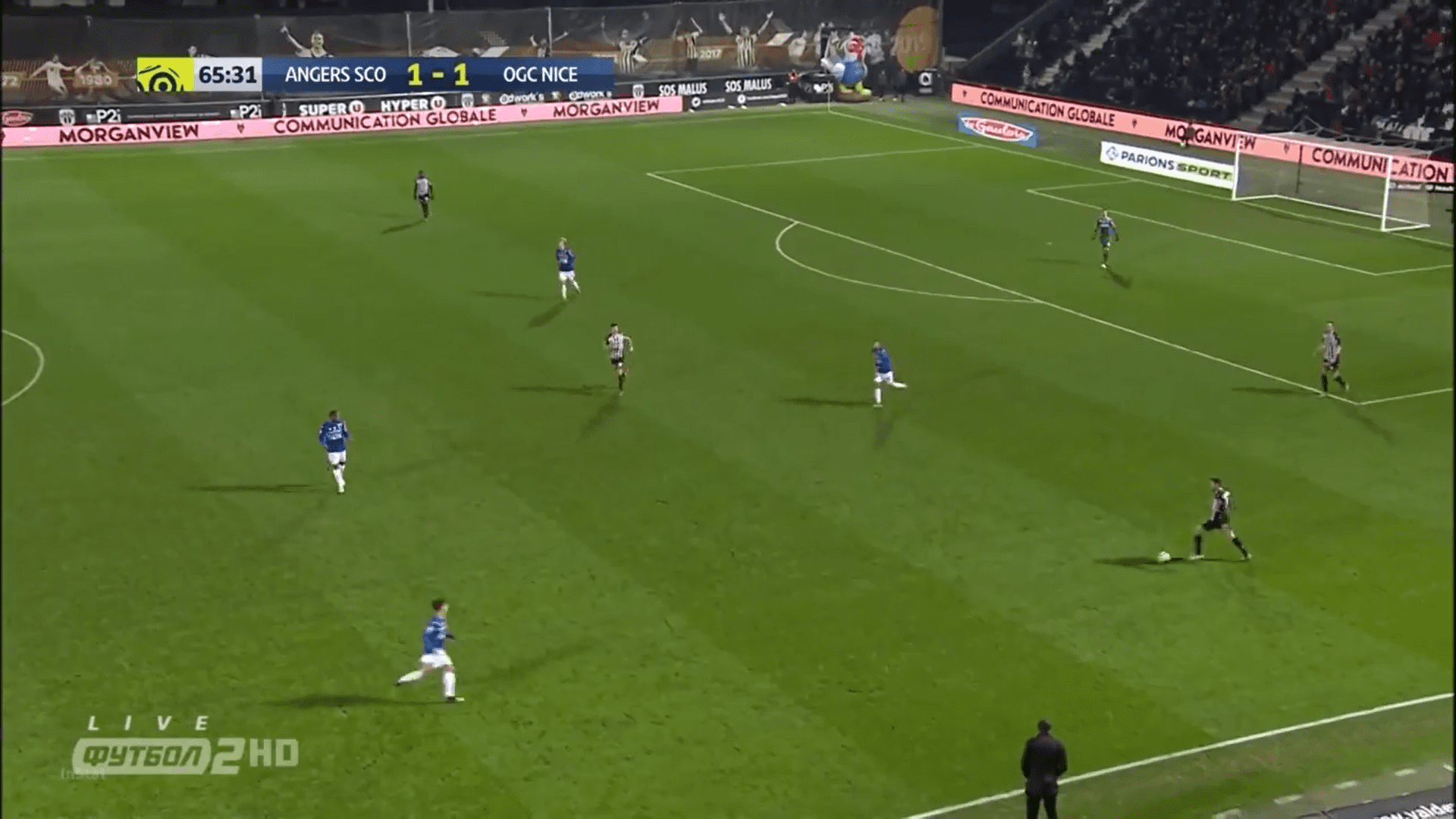
Defensive statistics
Nice’s defensive statistics are quite worrying.
They make the least defensive duels in the whole league with 56.92 but have a success rate of 61% in these, which is good.
Moreover, they are the second-worst team in aerial duels and loose ball duels.
They make 21.57 aerial duels with a success rate of 48%, meaning they lose more than half of their duels which is not good.
Then for the loose ball duels, they do 25.57 per game with a success rate of 44%.
Lastly, they also make the third least interceptions with 36.48 per game.
Overall, it seems that Nice need more intensity in their defensive play as they are doing badly in key defensive metrics.
We announced before that their defensive numbers had worsened by having conceded more goals in 28 games than they did in the whole of last season.
However, these more subtle metrics by which to measure the defensive prowess of a team are indeed agonizing and show that Vieira’s team needs more intensity to improve their defensive duels among others.
Conclusion
In conclusion, Patrick Vieira has improved Nice’s final position compared to last year’s but has worsened in their defensive capability.
We have seen that they like to attack from the middle for Dolberg to then switch the play and also, they rely on their wingers to create danger.
However, it is essential that Vieira takes a look at their defensive metrics and come with a plan to improve them because if they want to compete in Europe, they have to do better.




Comments